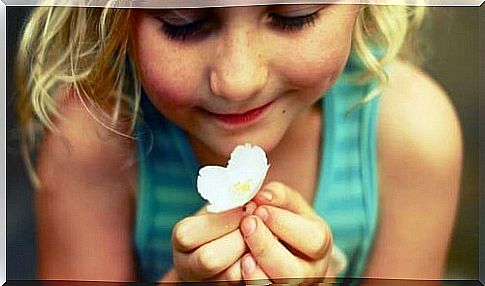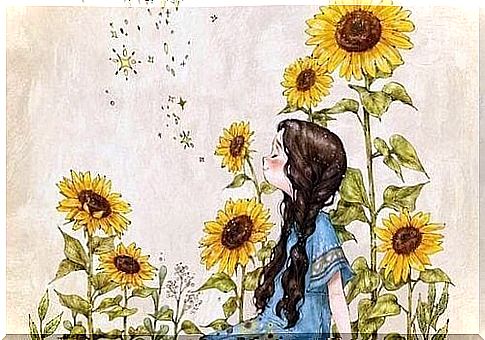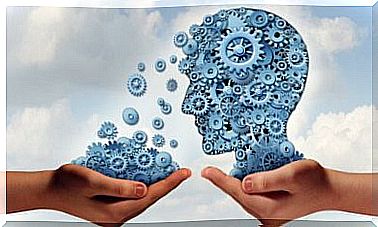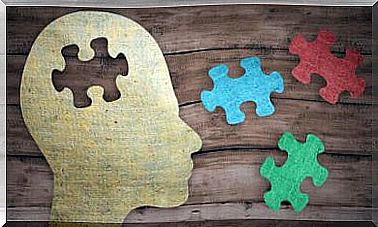Children Need Emotional Expression To Grow

“Do not cry”, “You are no longer a baby” or “You have to have fun” are very common expressions that adults use to “comfort” sad children. It may seem like they work for some children, at least in the short term. In the long run, however, they lead to children keeping their emotions to themselves. This silence can have serious consequences for their psychological and social development. Children need an outlet for emotional expression.
It is dangerous to ignore or deny children’s feelings. This should therefore be avoided when trying to promote their mental health. It can also affect the development of their relationships with others. Just because they are small does not mean that their thoughts and feelings are unimportant. In most cases, it is actually the opposite.
The truth is that their world is just as important as ours, and so are their feelings and perceptions. It is our job to give them support while they get to know themselves. Let us take a closer look at the noble task of teaching children to express and understand their emotions.
Anger, depression and irritation are natural reactions that children show in different situations. They may be because they do not understand what is happening or because they do not get what they want. Or maybe it’s just a rage. Whatever the reason, these are emotions that convey something more than just “I’m upset”. It is our job to understand what the children are trying to convey.
If you reject a child’s negative emotional expression, teach the child to drown in their grief.
What we need to do is interpret our children’s tears or anger and figure out what is behind it. If we instead reject their feelings or downplay them, we only reinforce their negative feelings. In addition, we announce them as individuals. We demand that they behave in a way that suits us but that is based on fear and emotional rejection.

If we suppress our children’s emotions, they as adults will not be able to handle emotional language. This applies to them personally, as well as to their relationships with others, and it has a negative effect on their health. It will also limit the development of their emotional intelligence. As the psychologist Daniel Coleman points out, understanding one’s own person and one’s own feelings is the cornerstone of mental health. It is the basis of personal development.
We do not have much experience in teaching children how to identify, express and release their emotions. This is especially true of negative emotions, such as anger, irritation and depression. When children give expression to this kind of emotion, we actually think they are rude, uncultivated or aggressive. If we do not teach them to come into contact with their emotional inner selves, they will never learn to understand themselves. As a result, they will never be able to handle their emotions.
If we want to raise our children to be emotionally intelligent and prosperous, we must start by letting them express their feelings. If we do not do this, they will become more and more upset until they begin to express themselves in other ways. They become prisoners of their emotions.
Being able to express irritation and depression has a redemptive and healing effect. It also helps us move forward and gain self-insight. That’s why it’s so important. And if children are taught appropriate emotional expressions at an early age, they will become mentally well-off as adults. When we strive to give our children an emotional upbringing, this means investing in them as adults. We must not forget that.
It is important to communicate to the children that all emotions are essential.
There are many ways for children to express how they feel and channel their negative energy. This can be anything from tears to the process of identifying one’s feelings one step at a time.
The most important thing is to be aware that this is a necessary process for them. Never react with anger, criticism or threats. We must never lose control. We must be their support when they are having a hard time, because they cannot solve their problems on their own. This is especially true during the very first years of life. Children need to be in a calm environment and not among people who incite their anger.
Our attitude towards children must be based on love, sensitivity and empathy. In this way we can help them figure out what gives rise to their feelings and how they can give outlet to them. This kind of process also allows them to learn to control their emotions.
When we want to teach children to understand what emotions they experience, we can teach them about the facial expressions, body movements and tone of voice that are linked to the different emotions.

One thing to avoid is trying to reason with children when they are angry or upset. We can suggest that they express what they feel, but waiting a few minutes usually helps them calm down.
This is the best time to have a dialogue. We can encourage them to express everything they feel and need to feel better. It is also important that we make them understand that when they express themselves, they have the opportunity to think and act in an appropriate way. The rule of thumb is not to insult or hurt anyone else.
A popular technique for teaching children about emotional expression is the traffic light technique. The purpose is to get the children to associate the colors of the traffic light with their feelings and behaviors. To do this, draw a traffic light and explain the following:
- Red light. We associate this color with stopping. So when you feel angry or nervous, or you want to scream or fight, remember that the red light is on and you have to stop. It’s like being a car driver and stopping at a traffic light. The message is: “Stop! Calm down and think. ”
- Yellow light. This color means you have to stop and think so that you can figure out what the problem is and how you feel. You can tell the children that when the light is yellow, the driver stops to think, look for solutions and get ready to drive on. Here you can say: “Think of solutions and consequences.”
- Green light. This light means you can continue. Choose the best solution and make sure you execute it. The message that helps children in these situations is: “Make sure you use the best solution.”
Draw to express yourself
Another technique that usually works when children are upset is to ask them to draw a picture of their anger. Then talk about everything they need. Finally, ask them to tear up the drawing. This is a symbolic way for them to get rid of the anger after they have communicated it.
They can also count to ten, sit alone for a little while or take a deep breath. Then reflect together on what made them feel the way they did. Talk about how they can channel their emotions and how they can solve their problems. The final stage encourages awareness, emotional expression and responsibility.

As we see , children can express and vent their negative emotions. The problem is often that they do not know how to do it. Our job is to help them express their feelings by giving them a positive emotional upbringing based on understanding and love.








